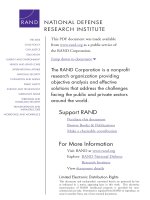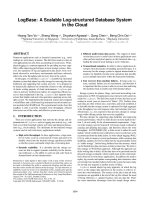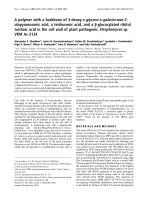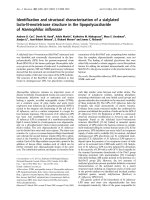Build up a balance scorecard for annual planning in the training center of viet capital bank to achieve the bank objectives for next years
Bạn đang xem bản rút gọn của tài liệu. Xem và tải ngay bản đầy đủ của tài liệu tại đây (1.2 MB, 44 trang )
HO CHI MINH CITY OPEN UNIVERSITY
UNIVERSITÉ LIBRE DE BRUXELLES
SOLVAY BRUSSELS SCHOOL OF
ECONOMICS & MANAGEMENT
MBQPM4
TRINH VAN THUY
BUILD UP A BALANCE SCORECARD FOR
ANNUAL PLANNING IN THE TRAINING
CENTER OF VIET CAPITAL BANK TO
ACHIEVE THE BANK OBJECTIVES FOR
NEXT YEARS
MASTER FINAL PROJECT
MASTER IN BUSINESS QUALITY AND PERFORMANCE MANAGEMENT
Ho Chi Minh City
(2014)
1
Statement of authentication
This is my own research. Data and results of the paper are faithful and have not been
published in any other research.
Author
Trinh Van Thuy
2
Acknowledgement
I would like to thank members of hochiminh city Open University and Solvay brussels
school of economics & management for all the supporting during the courses.
I would like to thank especially Professor Jacques Martin for his enthusiasm in sharing
experience and knowledge during the course in Vietnam as well as for this thesis.
I also would like to thank the training center of Viet Capital bank and Viet Capital bank
for the supporting and sharing data and information about the bank.
Thanks very much indeed.
Author
Trinh Van Thuy
3
Table of Contents
Statement of authentication .......................................................................................................................1
Acknowledgement .....................................................................................................................................2
List of Symbols and Abbreviations ............................................................................................................4
List of Figures ...........................................................................................................................................5
List of Table ..............................................................................................................................................6
1. INTRODUCTION .................................................................................................................................7
1.1 Subject studied ............................................................................................................................... 7
1.2 Scope and Delimitation ..................................................................................................................7
1.3 Research Methodology...................................................................................................................8
1.4 Research Method............................................................................................................................8
1.5 Thesis structure ..............................................................................................................................8
PART I: BALANCED SCORECARD OVERVIEW ..................................................................................9
1.1
1.2
1.3
1.4
The concept of balanced scorecard .......................................................................................... 9
Cause and effect in balance scorecard....................................................................................11
Strategy map ..........................................................................................................................12
Tool use and satisfaction ........................................................................................................13
PART II: ANALYSIS TRAINING CENTER OF VIET CAPITAL BANK ..............................................15
2.1
2.2
2.3
2.4
Bank profile............................................................................................................................15
Structure of Training center of in Viet Capital bank ..............................................................15
Operation of Training center in Viet Capital Bank ................................................................17
Investigation of problem in annual planning for VCTC ........................................................17
PART III: APPLIED BSC TO BUILD UP A BALANCE SCORECARD FOR ANNUAL PLANNING
IN TRAINING CENTER OF VIET CAPITAL BANK ............................................................................24
3.1
3.2
3.3
Steps to building a balanced scorecard ..................................................................................24
Six steps to develop a balanced scorecard for VCTC ............................................................24
Balance scorecard for annual planning in Training Center of Viet Capital Bank ..................32
RECOMMENDATIONS .........................................................................................................................41
CONCLUSIONS .....................................................................................................................................41
References ...............................................................................................................................................41
4
List of Symbols and Abbreviations
VCCB : Viet Capital Commercial Joint Stock Bank or Viet Capital Bank
VCTC : Training center of Viet Capital Bank or Viet Capital Bank Training Center
BSC
: Balance scorecard
SME : Small and medium enterprises
5
List of Figures
Figure 1.1: Four perspectives of the BSC model. ................................................................ 9
Figure 1.2: Cause and effect in balance scorecard............................................................. 11
Figure 1.3: Strategy map .................................................................................................... 12
Figure 1.4: Management Tools and Trends ....................................................................... 13
Figure 2.1: VCCB organization chart ................................................................................ 15
Figure 2.2: Structure of Training center of in Viet Capital bank ....................................... 16
Figure 2.3: Main training procedure of the center ............................................................. 17
Figure 2.4: Training processes in VCTC ........................................................................... 22
Figure 3.1: Translate strategy into objectives in VCTC .................................................... 29
Figure 3.2: Strategy map .................................................................................................... 30
Figure 3.3: Develop result and process measures .............................................................. 31
Figure 3.4: Balance scorecard logic ................................................................................... 32
6
List of Table
Table 2.1: 2013 annual training plan of VCTC ................................................................. 21
Table 3.1: BSC for financial perspective in VCTC ........................................................... 34
Table 3.2: BSC for internal business perspective in VCTC .............................................. 35
Table 3.3: BSC for Learning and growth perspective in VCTC ....................................... 36
Table 3.4: BSC for Customer perspective in VCTC ......................................................... 37
Table 3.5 : BSC for VCTC ................................................................................................ 40
7
1. INTRODUCTION
1.1 Subject studied
Training and development are important for an organization to retain and increase its
competitiveness. However, many companies struggle to establish well their training
function. Planning and performance of training must follow the organization’s vision,
strategy and goals that need to be defined clearly and communicated at all levels of the
organization. Furthermore, all efforts and actions must be focused on achieving the
organization’ goals.
Kaplan & Norton (1992) develops balance scorecard that is ranked six in top ten of most
used management tool until now. Today, BSC is widely used in various types of
enterprises of different industries. BSC helps to translate the vision and strategy of a
business unit into objectives and measure its specific targets and initiatives in four
perspectives: financial, customer, internal business process and learning – growth. It not
only record operational results but also explains the cause – effect of operational results,
and forecasts possible future.
General, BSC is developed at high-level corporate and then it forms the basis for
subsequent business unit. Sometimes a BSC begins in a strategic business unit or support
unit, in which case the unit scorecard is built first and becomes the basis for subsequent
unit and corporate scorecards. VCTC is a sample of building up BSC support unit first then
apply throughout the bank following the success of VCTC’s balance scorecard
This project is to discuss using Kaplan and Norton’s balance scorecard’s model to build up
a balance scorecard to make an annual plan in the Training center of Viet Capital Bank
showing the main objectives, indicators (measurement system) and actions to implement in
order to achieve the bank objectives for next years.
1.2 Scope and Delimitation
The research covers a journey to make an annual training plan for VCTC in Viet Capital
bank only. The purpose of the research is to find answers to the following two main
research questions
(1) What do steps need to make an annual plan for the Training center of Viet
Capital bank under BSC insight?
(2) What components are needed in a BSC for an annual training plan of VCTC?
Therefore, environmental factors would be focusing on strategy business of VCTC and
Viet Capital Bank in Vietnam.
8
1.3 Research Methodology
The research uses inductive approach, starting from data analysis and getting
understanding of a phenomenon. The research will use the combination of three types of
studies following as below:
Exploratory - finding what is happening and understanding a problem.
Descriptive - portray an accurate profile of a situation.
Explanatory - establish causal relationships between variables.
1.4 Research Method
The research collects data from real business curriculum of VCTC and Viet Capital bank
based on reports and records as primary source of data. The research also uses result of
other studies as secondary data source. To achieve research objectives, the author
combined two methods: qualitative research and quantitative research for all data collected.
In addition, Statistical tools would also be used for the research.
1.5 Thesis structure
To clarify the situation, this thesis is followed below structure:
Introduction
Part I: Balance scorecard overview
Part II: Analysis of training center of Viet Capital bank
Part III: Applied BSC to build up a balance scorecard for annual planning in
Training Center of Viet Capital Bank
Recommendations
Conclusions
9
PART I: BALANCED SCORECARD OVERVIEW
1.1 The concept of balanced scorecard
Historically, performance measurement systems have been financial in nature for most
businesses. Unfortunately, financial indicators don't tell the entire story about the
companies in many business situations. Financial indicators are needed, but these only tell
us what has happened in the past, where the operations took place. Financial statements do
not tell us what problems will occur in the front and what happen to the business in the
future. This shows that we are operating businesses similar driving a cars just by looking at
the rear-view mirrors! In addition, comparing two companies with similar financial
situations but in completely different market environments could be disastrous. For
example, a company can reduce the level of customer service to increase current profits,
but in the long term, future profits can be negatively affected due to descending customer
satisfaction
Realizing the limits of old financial indicator system, Robert S. Kaplan and David Norton
developed a new performance measure system namely balance scorecard in a series of
articles for the Harvard Business Review in the mid- 1990s. In which, not only the
financial measures, but also measures of customer, internal processes, training and
development are put in to consideration. Kaplan & Norton (1992) described BSC is a
strategic measure system including both non-financial and financial measure to measure
the performance of a business organization. BSC adopted quickly by academic scholars
and practitioners and is appreciated as one of the 75 most effective ideas of the twentieth
century by the Harvard Business Review. BSC helps to translate the vision and strategy of
a business unit into objectives and measure its specific targets and initiatives in four
perspectives: financial, customer, internal business process and learning – growth. It not
only record operational results but also explains the cause – effect of operational results,
and forecasts possible future (Figure 1.1: Four perspectives of the BSC model).
Figure 1.1: Four perspectives of the BSC model.
Source: Kaplan, R.S. & Norton, D.P. (1992)
10
Thus, we can understand the BSC as a management tool, it helps businesses set up,
implement and monitor to achieve strategic goals through the translation and development
of strategic goals into specific targets and initiatives basing on four perspectives: financial,
customers, internal processes, learning and growth as shown in Figure 1.1 above.
Andersen (2001) believes that BSC and its associated management process can prove
equally beneficial to SMEs as to large organizations. He stated that BSC can prove an
effective tool for companies in meeting the challenge posed by the need to introduce more
efficient strategic planning processes while retaining the competitive advantage of having
relatively simple structure
Success stories of organizations that have implemented BSC seem to promise high benefits
for BSC users. Several surveys indicate that the BSC concept is widely used in large
organizations in the United States and throughout Europe. For example, Williams (2001)
estimates that more than 40% of all Fortune 500 US organizations use BSCs. Another
study estimates that 60% of the Fortune 1000 organizations in the USA have had
knowledge with BSC (Silk, 1998). Rigby (2001) stated that BSC has a utilization rate of
44%. Some benefits of implementing the BSC are suggested as below.
A key advantage of the balanced scorecard is that it puts strategy, structure, and
vision at the center of management’s focus. Furthermore, BSC was constructed to
tell the story of an organization strategy and to guide its implementation.
Balanced scorecard emphasizes an integrated combination of financial and nonfinancial performance measures. It keeps management focused on the entire
business process and helps ensure that actual current operating performance is in
line with long-term strategy and customer values. Moreover, Chow, Haddad, &
Williamson (1997) argue that BSC retains traditional financial measures and these
financial measures are viewed in the larger context of a company’s competitive
strategies for creating future value through investment in customers, suppliers,
employees, processes, technology, and innovation.
The cause-and-effect linkages of the BSC confine the difficulty and
interrelationships of a strategy, facilitating explicit tradeoffs among quality, cost,
and access.
The researchers also state that companies have benefit above from applying BSC whether
the companies are large or SMEs (Basuony, 2014)
11
1.2 Cause and effect in balance scorecard
Figure 1.2: Cause and effect in balance scorecard
The figure 1.2 shows that four perspectives in BSC have closely relationship under cause
and effect principle. For the vision, strategy and shareholders’ expectation, the first is
financial perspectives. To hit the financial target, company must satisfy its customer. For
the customer satisfaction, companies have to develop solid internal procedure. Then
learning and development are infrastructure for a good internal management system for
client’s satisfaction, financial target and shareholder expectation toward vision and strategy
of the company
In most presentations of the balanced scorecard the so-called cause and effect principle has
been a core feature of the BSC. The cause-and-effect principle has been developed with
inspiration from the service management literature (Heskett et al. 1997) towards a generic
business model in the form of the strategy map (Kaplan & Norton 2001, 2004 )
Some authors (Nørreklit, 2000, 2004; Brignall 2002) have, however, questioned the logic
of the cause-and-effect principle. They have questioned the practicality of BSC as a
method on the premise that no cause and effect relationship exists between measurement
areas. However, researchers state that the view on question of cause-and-effect in BSC is
mistaken and we can see the principle as “fundamentally an applied research area that
should ultimately provide new insights for practice” (Ittner et al, 2002, p.788, see also
Mitchell, 2002). We acknowledge that cause-and-effect, as well as other design principles
of scorecards, may only partially explain the potential benefits from BSC. It seems that
research and practitioners should pay much more attention to how people in organizations
actually use various types of scorecards to commit action.
12
1.3 Strategy map
Figure 1.3: Strategy map
A strategy map is a diagram that is used to document the primary strategic goals being
pursued by an organization with all aspects to get a successful strategy. The first diagrams
of this type appeared in the early 1990s, and the idea of using this type of diagram to help
document Balanced Scorecard was discussed in a paper by Dr. Robert S. Kaplan and David
P. Norton in 1996 as the figure 1.3 above. This map will be mentioned later in building a
BSC for the VCTC.
Kaplan and Norton (2002) stated that there are five key principles common to all
successful balanced scorecard companies: translate the strategy to operational terms; align
the organization to the strategy; make the strategy everyone’s everyday job; make strategy
a continual process; mobilize change through executive leadership. 4 of these five
principles look forward directly to the company’ strategy. The key principles of strategy to
successful use of BSC can help large structured companies to overcome the difficulties in
their characteristics. For example, aligning the organization to the strategy can help to
overcome the formal and bureaucratic administration in organization. Another example, if
the organization makes the strategy everyone’s everyday job through the use of BSC, then
the challenges and difficulties of communication and co-ordination in large firms can be
minimized. Currently, strategy maps and cause-and-effect relationships attract considerable
interest among practitioners in Scandinavia, and some firms are developing their BSC
based on strategy mapping (Kasurinen, 2002, Bukh et. al 2004). This shows that the
important of strategy map in the successful balance scorecard companies.
In addition, strategy map is a map that creates value for the company by providing
specificity needed to translate general statements about high-level direction and strategy
13
into specific objectives that are more meaningful for all employees and that they can act
on, direct their action on the same objectives. Strategy map helps to balance long-term and
short-term objectives in the financial perspective, differentiate value proposition in the
customer perspective, create value through internal business processes, and strategic
alignment of intangible assets in the learning and growth. Hence, the strategy also helps
companies by ultimate objectives of four perspectives and putting all the pieces together
(Kaplan and Norton, 2004)
1.4 Tool use and satisfaction
Bain & Company has been conducting global Management Tools and Trends surveys since
1993. Never before have we surveyed executives during a period of such economic
turbulence. It is a sign of the times that a cost cutting tool Benchmarking-has become the
most popular tool for the first time in 11 years. The latest questionnaire was conducted in
January 2009 and reflects behavior in 2008. (See figure 1.4) It was completed by 1,430
international executives from companies in a broad range of industries and focuses on 25
tools. The survey also show that BSC ranked 6 in top ten of most used tool. It is used 53%
among companies and have satisfaction rate of 3.83/5 point
Figure 1.4: Management Tools and Trends
Source: Bain & Company, 2008
14
Today, BSC is widely used in various types of enterprises of different industries. On the
overall, the research and application of the BSC follow two main directions (1)application
research in non-profit organizations and (2) application research in for - profit
organizations.
This paper aims to apply BSC for the training function as a sub-organisation that direct
link to profit generating capability of a for-profit enterprise.
15
PART II: ANALYSIS TRAINING CENTER OF VIET CAPITAL BANK
2.1 Bank profile
Viet Capital bank is a small commercial local bank of Vietnam. It has 37 transaction
offices and over 1.000 employees nationwide. Its chatter capital is 3.000 billion VND
(approximately 150 million USD) and asset of 23.000 billion VND (approximately 1.1
billion USD) in 2013. It operates in all fields of a commercial bank such as loan, credit,
deposit, export credit, international payment, account management credit, debit card, interbank market, capital market, investment, ..etc.
The organization structure of Viet Capital Bank is below:
Figure 2.1: VCCB organization chart
Source: />2.2 Structure of Training center of in Viet Capital bank
Viet Capital bank training and development function is a center under directly board of
management supervision and operates independent from Human Resource department.
The center takes responsibility for all training aspects throughout the bank. It also develops
training activities that link directly to sales campaign or its own sales development
campaigns.
The training and development center has 3 departments these are soft-skill, knowledge
cum hard-skill, and administration department.
16
Soft-skill department is in charge of research, training soft-skills such as: sales,
communication, train the trainer, leadership..ect.
Knowledge cum hard-skill department is in charge of research, training professional
knowledge such as core-banking soft-wares, bank production, micro and macro-economic,
orientation for new employees...etc.
Training - admin department is in charge of supporting activities such as organizing
training class, preparing contracts, update trainees and trainings records...etc.
In addition, VCTC develops internal trainers who are experts, managers, specialists in all
functions of the bank. It also has relationship with external trainer, free-land trainer,
training companies, education institute for outsourcing if needed.
The VCTC is organized as chart below:
Head of training
Hard-skills
department
Soft-skillss
department
Training-admin
department
Other bank
functions
External trainer - outsources
Figure 2.2: Structure of Training center of in Viet Capital bank
The center has main functions as below:
a) Taking all responsibility about training and development throughout of the bank
b) Establish training and development policies and procedures to ensure efficiency
and effectiveness of training and development.
c) Developing and operating campaign to support bank’ strategy to get the targets
d) Enable employee to acquire the knowledge and skills to improve their performance.
e) Implement training and development activities.
f) Implement activities for carrier roadmaps.
g) Budget and manual expenses in the training and development.
h) Administer and follow up the performance appraisal & management review.
In the bank, VCTC is considered a professional service organization that supply training
and development activities only for the bank but help to contribute and improve profit
generating capability of the bank.
17
2.3 Operation of Training center in Viet Capital Bank
Annually, head of training center makes a plan, estimates budget and target for the whole
next year. Under the plan, each training departments take its own responsibility by its
functions and under alignment with other for joining activities.
Each training department then makes its plan to hit the assigned target of the departments
and whole training center. The plan will be divided and assigned to each member in the
team for short term.
Monthly, head of training center synthesizes training demand of the bank and monthly plan
of training departments to a monthly schedule then public the schedule for the bank
through internal network called intranet.
Training - admin department then collect enrolment from banks’ department, notifying to
registers and organizing training classes as well as following activities. The main training
procedure of the center describes by figure 2.3 below and sub-processes connect to the
main procedure
Figure 2.3: Main training procedure of the center
2.4 Investigation of problem in annual planning for VCTC
Training is important for an organisation to retain and increase its competitiveness
(Ramsay, H., Dora Scholarios, D., and Harley, B.,: British Journal of Industrial Relations
38:4 December 2000, pp. 501). However, many companies struggle to establish well their
18
training function and find it difficult to make its plan to link to the organisation’s strategy
and objectives.
There are 3 parts in annual plan of VCTC in 2013 included:
- Training plan: 73 courses included 12 outsourcing courses (for approximately total 400
persons), 61 internal courses (for approximately total 2.100 personal)
- Budget plan: 2.5 billion VND
- Human resource: 8 headcount
See detail of an annual training plan as table 2.1 below:
19
Annual training plan and budget of Training center 2013
(from 01/01 - 31/12/2014)
1 - Training plan
Money unit: thousand VND
Total: 73 courses
Ordinal
Attendants
Subjects
Class
quantity
Courses
budget
Time
Training
modality
1
Sales skills
3
3510 Quarter 3, 4
Internal
2
Credit proposal skills
3
3450 Quarter 3
Internal
3
Formal documentary
1
1550 Quarter 4
Internal
4
Regular risk in credit assessment
1
1250 Quarter 3
Internal
5 Customer relationship officers
Procedure for credit and credit proposal
1
6
Credit risk assessment
2
7
Products of the bank
2
8
Analysis and assessment a company
financial report
Analysis and assessment a business
project
Telephone skills
1
30580 Quarter 4
Outsource
1
47580 Quarter 3 or4
Outsource
2
1180 Quarter 1, 2
9
10
Teller/ teller supervisor
435 Quarter 1, 3
31160
1740 Quarter 3, 4
Internal
Outsource
Internal
Internal
Note
20
11
Sales skills
2
1760 Quarter 2, 3
Internal
12
Communication and customer services
2
1760 Quarter 1, 3
Internal
13
Consulting skills for deposit products
1
590 Quarter 2, 3
Internal
14
Products of the bank
3
3480 Quarter 1, 3
Internal
15
Functions of the bank
2
6960 Quarter 1, 3
Internal
16
Money verification
2
10580 Quarter 2, 4
Outsource
17
Documentary verification
1
25580 Quarter 3 or 4
Outsource
18
Basic change management
1
1445 Quarter 3, 4
19
Products of the bank
2
5000
20
Core banking - first period
11
6380 Quarter 1
Internal
21 Staffs of the bank
Core banking - second period
11
6380 Quarter 2
Internal
22
Orientation training
3
3750 Quarter 1 - 4
Internal
23
Presentation skill
1
880 Quarter 1, 2
Internal
24
Culture of the bank
2
3100 Quarter 1, 2
Internal
25
Online test for banking knowledge
26 Managers and assistant managers
Advanced change management
Internal
Internal
1
41280 Quarter 2
Outsource
21
27 Managers and assistant managers,
Directors and assistant directors
28 Assistant managers and supervisors
Credit risk management for managers
1
25980 Quarter 3 or 4
Outsource
Basic management skills
1
30880 Quarter 3
Outsource
29 Assistant managers and supervisors
Counter management skills
1
35880 Quarter 3 or 4
Outsource
30 Assistant managers and supervisors
Teamwork skills
1
48880 Quarter 2 or 3
Outsource
31 Training director
1
20000
32 Branch directors and potentials
Analysis and training performance
assessment
Branch/ office transaction management
1
3090 Quarter 3
Outsource
33 Branch directors and potentials
Business plan and implement
1
6180 Quarter 3
Outsource
34 Branch directors and potentials
Marketing and sales management
1
6180 Quarter 3
Outsource
35 Branch directors and potentials
Quality management
1
3090 Quarter 3
Outsource
36 Branch directors and potentials
Risk management
1
6180 Quarter 3
Outsource
37 Branch directors and potentials
Human resource management
1
456180 Quarter 3
Outsource
Total training plan: 73 courses included 12 outsourcing courses (for approximately total 400 persons), 61 internal courses ( for
approximately total 2.100 personal)
2 - Budget: 2.5 billion VND
3 - Headcount: 8
Table 2.1: 2013 annual training plan of VCTC
22
The VCTC annual plan criterions under BSC insight:
a) Customer: to achieve the vision, VCTC annual plan appear its customer by the
supplying training service to them. They also include: measures, targets and
initiatives but absence objectives for the customer perspectives.
b) Financial: in this perspective, the VCTC plan meets meet objectives, measures,
targets and initiatives in the expenditure its budget but not contribute anything in
the profit contribution to the shareholders (how should VCTC appear to its
shareholders) in the 3 aspects:
- Business creation: Activities to support business in generating profit
manner or create business itself to make funds for its operation. This is the
main reason for existing of training and development function.
- Source of funds: making funds for training activities. Training cannot
survive without funds.
- Cost effectiveness: maximize the return of investment for training
expenditure. It is the reason the bank should remain and continues investment
on training.
c) Internal business process: in the VCTC, there is enough process to meet its internal
business. It has 27 processes and sub-processes as figure 2.4 below. The processes
satisfy its shareholders and customers by the objectives, measures, targets and
initiatives.
Figure 2.4: Training processes in VCTC
The processes focus on 3 purposes: quality management, cross-function management,
objective management.
23
- Quality management: to manage quality of training issues. For example:
quality management processes of the trainers, training materials and
documentaries ..etc).
- Cross-function management: to help workflow smoothly across functions and
departments in the VCTC and beyond. For example: billing process, payment
process..etc.
- Objective management: to manage objectives of VCTC follow its own
strategy and the bank. For example: budget planning process, monthly planning
process.
VCTCs’ activities have to refer strictly to these processes for management. The
training centre will be audited periodically and faced to punish for any violation.
d) Learning and growth: VCTCs’ objectives, measures, targets and initiatives have
met learning and growth perspective by supplying sustains ability to change and
improve in competency and competitive capability in the bank.
In the brief, the there are two main problems in BSC aspects in the annual plan of VCTC.
It is the absence from objectives for the customer in the customer perspectives and do not
show contributing to the shareholders in the generating profit insight
24
PART III: APPLIED BSC TO BUILD UP A BALANCE SCORECARD FOR
ANNUAL PLANNING IN TRAINING CENTER OF VIET CAPITAL BANK
3.1 Steps to building a balanced scorecard
At the middle level of strategy, sometimes called management (or department) strategy,
managers or head of departments develop the strategies for their business units that support
overall organization strategy and help organization to reach its goals. However, when
developing a strategy, nobody knows which strategies are successful and which are not,
they must be treated as hypotheses. The strategies are also analyzed and tested with
available date from the scorecard management system. So that we need a framework to
develop and manage strategy, and align the work we do with the goals of the organization.
Rohm (2002) stated that development a balance scorecard is not a project but also a
journey. While there are discreet start and stop points along the way, one should not miss
the point that the real value of a scorecard system comes from the continuous self-inquiry
and in-depth analysis that is at the heart of all successful strategic planning and
performance management systems. Start your balanced scorecard with the idea that you are
in it for the long term, and that changing behavior is at least as important as measuring
performance.
Rohm (2002) also stated that the scorecard journey has two phases: building a balance
scorecard and implementing a balance scorecard.
- Phase 1: Building a balance scorecard. There is six-step framework to build an
organization’s balanced scorecard.
- Phase 2: Implementing a balance scorecard. There are additional three steps to implement
the scorecard system throughout all levels of an organization.
Because the limit and scope of the thesis, we just analysis and go through 6 steps of phase
1: Building a balance scorecard for an organisation. At the end of the first six steps, the
high-level corporate BSC is developed and it forms the basis for subsequent scorecard
development.
In general, BSC is developed at high-level corporate and then it forms the basis for
subsequent business unit. Nevertheless, sometimes a BSC journey begins in a strategic
business unit or support unit, in which case the unit scorecard is built first and becomes the
basis for subsequent unit and corporate scorecards. This is true in Vietcapital bank. VCTC
develop BSC as a sample case then apply throughout the bank under the success of
VCTC’s balance scorecard.
3.2 Six steps to develop a balanced scorecard for VCTC
There are six steps to develop a balanced scorecard.
Step one is an assessment of the organization’s foundations, its core beliefs, market
opportunities, competition, financial position, short/ long-term goals, and an









